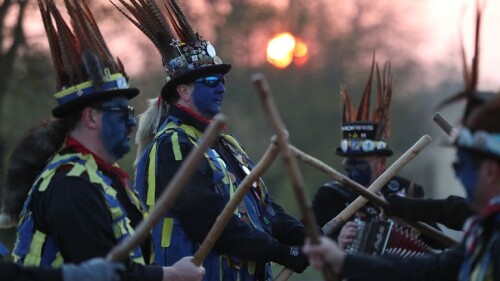
Morris dancers ditch black face paint and swap it for blue following racism concerns.
The tradition is believed to have derived from poor farm workers in the 1400s using soot to disguise themselves so they could beg.
Members of the Hook Eagle Morris Men perform outside the Shack Cafe near to Hook in Hampshire as they see in the May Day dawn. It is the first time they have been able to perform together since January 2020 and is the first time they have performed in their new Blue face paint.
Morris dancers have swapped their black face paint over racism concerns
A group of morris dancers in Hampshire have swapped their traditional black face paint for blue, following concerns over racism.
The Hook Eagle Morris Men performed near the village of Hook in Hampshire on Saturday to mark May Day dawn, in their first show since January 2020.
Last June, cross-county group the Joint Morris Organisations put out a statement to ask dancing groups to stop the use of full-face black makeup in response to the Black Lives Matter movement in the wake of the death of George Floyd.
Members of the Hook Eagle Morris Men perform outside the Shack Cafe near to Hook in Hampshire as they see in the May Day dawn. It is the first time they have been able to perform together since January 2020 and is the first time they have performed in their new Blue face paint.
The practice of painting faces is thought to have originated in the 1400s
John Ellis, 70, who dances with the Hook Eagle Morris Men has been with the group since its inception as a church group in 1991, and describes the move as "by far and away the biggest if not really the only change we've experienced".
He added that other troupes around the UK has changed their face paint to different colours, with some opting for green, while a group in Kent now uses black and yellow stripes.
Mr Ellis says the tradition of using black face paint derived from when poor farm workers in the 1400s would use soot to disguise themselves so they could beg - which was illegal at the time.
That tradition "died out", according to Mr Ellis, but it was revived in the 1970s by border morris dancers, which was a type of dance that originated on the England-Wales border...